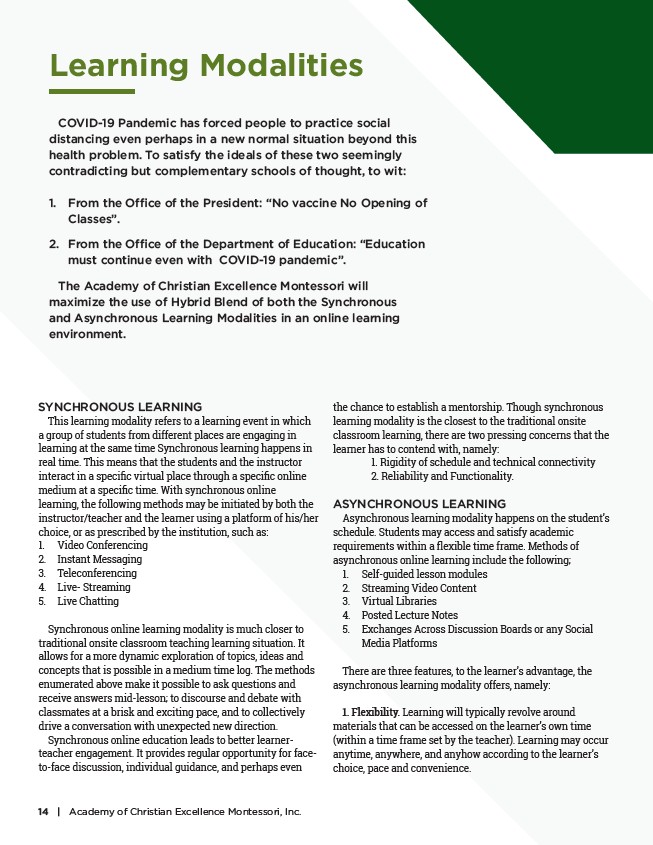
Learning Modalities
COVID-19 Pandemic has forced people to practice social
distancing even perhaps in a new normal situation beyond this
health problem. To satisfy the ideals of these two seemingly
contradicting but complementary schools of thought, to wit:
1. From the Office of the President: “No vaccine No Opening of
Classes”.
2. From the Office of the Department of Education: “Education
must continue even with COVID-19 pandemic”.
The Academy of Christian Excellence Montessori will
maximize the use of Hybrid Blend of both the Synchronous
and Asynchronous Learning Modalities in an online learning
environment.
SYNCHRONOUS LEARNING
This learning modality refers to a learning event in which
a group of students from different places are engaging in
learning at the same time Synchronous learning happens in
real time. This means that the students and the instructor
interact in a specific virtual place through a specific online
medium at a specific time. With synchronous online
learning, the following methods may be initiated by both the
instructor/teacher and the learner using a platform of his/her
choice, or as prescribed by the institution, such as:
1. Video Conferencing
2. Instant Messaging
3. Teleconferencing
4. Live- Streaming
5. Live Chatting
Synchronous online learning modality is much closer to
traditional onsite classroom teaching learning situation. It
allows for a more dynamic exploration of topics, ideas and
concepts that is possible in a medium time log. The methods
enumerated above make it possible to ask questions and
receive answers mid-lesson; to discourse and debate with
classmates at a brisk and exciting pace, and to collectively
drive a conversation with unexpected new direction.
Synchronous online education leads to better learnerteacher
engagement. It provides regular opportunity for faceto
face discussion, individual guidance, and perhaps even
the chance to establish a mentorship. Though synchronous
learning modality is the closest to the traditional onsite
classroom learning, there are two pressing concerns that the
learner has to contend with, namely:
1. Rigidity of schedule and technical connectivity
2. Reliability and Functionality.
ASYNCHRONOUS LEARNING
Asynchronous learning modality happens on the student’s
schedule. Students may access and satisfy academic
requirements within a flexible time frame. Methods of
asynchronous online learning include the following;
1. Self-guided lesson modules
2. Streaming Video Content
3. Virtual Libraries
4. Posted Lecture Notes
5. Exchanges Across Discussion Boards or any Social
Media Platforms
There are three features, to the learner’s advantage, the
asynchronous learning modality offers, namely:
1. Flexibility. Learning will typically revolve around
materials that can be accessed on the learner’s own time
(within a time frame set by the teacher). Learning may occur
anytime, anywhere, and anyhow according to the learner’s
choice, pace and convenience.
14 | Academy of Christian Excellence Montessori, Inc.